Food coloring
From Wikipedia, the free encyclopedia
Food coloring is a substance, liquid or powder, that is added to food or drink to change its color. Food coloring is used both in commercial food production and in domestic cooking. Due to its safety and general availability, food coloring is also used in a variety of non-food applications, for example in home craft projects and in education.
People associate certain colors with certain flavors, and the color of food can influence the perceived flavor in anything from candy to wine.[1] For this reason, food manufacturers add these dyes to their products. Sometimes the aim is to simulate a color that is perceived by the consumer as natural, such as adding red coloring to glacé cherries (which would otherwise be beige), but sometimes it is for effect, like the green ketchup that Heinz launched in 1999.
Purpose of food coloring
While most consumers are aware that food with bright or unnatural colors (such as the green ketchup mentioned above, or children's cereals such as Froot Loops) likely contain food coloring, far fewer people know that seemingly "natural" foods such as oranges and salmon are sometimes also dyed to mask natural variations in color.[2] Color variation in foods throughout the seasons and the effects of processing and storage often make color addition commercially advantageous to maintain the color expected or preferred by the consumer. Some of the primary reasons include:
- Offsetting color loss due to light, air, extremes of temperature, moisture, and storage conditions.
- Masking natural variations in color.
- Enhancing naturally occurring colors.
- Providing identity to foods.
- Protecting flavors and vitamins from damage by light.
- Decorative or artistic purposes such as cake icing.
- Birthdays and other celebration






No comments:
Post a Comment